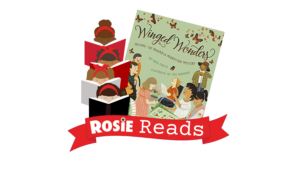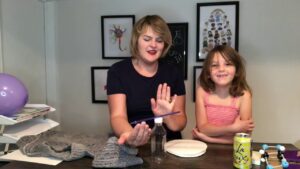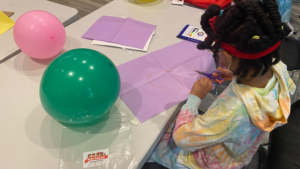
Pre-Built Lesson: Static Electricity
Static electricity gets students charged up for science! In this STEM lesson plan for elementary schoolers you’ll experiment with static electricity. You’ll also learn about monarch butterflies and then make static electric butterflies.
Resources in This Lesson
Resource 1
Use the magic of science to experiment with this fun trick! You’ll channel the power of static electricity to move an object with no hands.
Rosie Explores Static Electricity
https://handsonstem.rosieriveters.com/resources/static-electricity/
Resource 2
For our book, we’re reading Winged Wonders, which details the mystery behind monarch butterfly migration and the people who discovered the answers.
Rosie Reads Winged Wonders
https://handsonstem.rosieriveters.com/resources/rosie-reads-winged-wonders/
Resource 3
Put your knowledge into action by making butterflies with wings that move with only static electricity – no batteries needed!
Rosie Makes Static Electric Butterflies
https://handsonstem.rosieriveters.com/resources/rosie-makes-static-electric-butterflies/
Resource 4
Continue learning and exploring with some of these tried and tested Rosie Recommends activities from other STEM educational resources.
Rosie Recommends Static Electricity Activities!
https://handsonstem.rosieriveters.com/resources/static-electricity-activities/
Check out these tried and tested static electricity activities from other STEM educational resources!
Recommended Resources
Resource 1
This fun experiment from some friends at the Institute of Physics uses a drinking straw, plastic bottle cap, and cloth to create static electricity that makes a straw move! This is also a great project to get thinking about the role friction plays in static electricity.
Resource 2
Learn about electroscopes with this fun project! A device that detects electrical charge, you’ll be able to use your electroscope to figure out which objects around you build up and conduct electricity the best. You’ll need a few materials to get started, including a cup, drinking straw, tape, aluminum foil, various types of cloth or material, and a plastic ruler. Make sure to keep track of your results in the chart provided!
Join Rosie Girls Veronica and Grace as they get “charged up” to explore static electricity by creating their own static electric butterflies.
Check out Rosie Explores Static Electricity to learn more about the science of these fluttering butterfly wings.
Ready to make this project at home or in your classroom? Watch the video for an overview, gather the materials listed to the right, and follow the instructions below!
Watch The Video
https://youtu.be/k9s5JODy-O0
Required Materials
- cardboard
- tissue paper
- markers
- scissors
- balloon
- piece of cloth
Step-By-Step Instructions
Step 1
Fold the tissue paper in half.
Step 2
Draw a backwards letter “B” along the fold of the paper.
Step 3
Cut the “B” shape out using scissors. Make sure you’re cutting two layers at once!
Step 4
Cut along the center of the fold to create two separate wings.
Step 5
Decorate your wings.
Step 6
Tape the edge of the wings to the cardboard. Remember to leave space for the body.
Step 7
Draw the butterfly’s body between the wings.
Step 8
Blow up a balloon.
Step 9
Rub the balloon along a cloth (wool works best) to build up a static charge!
Step 10
Use the “charged” balloon to make your butterfly’s wings flutter!

Monarch butterflies are famous for their long migration across North America. However, their journey was once a mystery. In this episode of Rosie Reads we’re exploring the mystery of monarch butterfly migration with the book Winged Wonders: Solving the Monarch Migration Mystery by Meeg Pincus. We’ll discover more about the life of monarch butterflies and who solved the question of their migration in 1976!
While reading Winged Wonders, ask kids these comprehension questions:
- What do monarch butterflies eat?
- Who solves the question of monarch butterfly migration?
- Where do monarch butterflies go?
For our Rosie Reads activity, think of something big you want to solve and who you would want on your team to figure it out? Who do you want to work with? Why? What are some other things your team could do to help the monarch butterflies?
Watch The Video
https://youtu.be/_tHZddwx9Tc

Explore the power of static electricity with these fun hands-on experiments.
Have you ever gotten a “shock” while walking or running in your socks or watched someone’s hair fly up in the air when it’s rubbed against a balloon? If you have you’ve seen static electricity in action! The rubbing between those two objects (eg. socks & floor or hair & balloon) causes some of the electrons in an atom to break away. But atoms like to be balanced. So if an electron is floating free in the world what will it work to do? Find a proton to ATTRACT to!
Want to duplicate this experiment at home or in your classroom? Watch the video for an overview, gather the materials listed at the right, and follow the instructions below!
Watch The Video
https://youtu.be/1e5QiLUuUsQ
Required Materials
- can
- straw
- plastic bottle
- balloon
Step-By-Step Instructions
Step 1
Blow up your balloon, and tie it off.
Step 2
Rub it on your shirt. It’s best if you use a wool material.
Step 3
Hold it over your head, and watch what happens to your hair! Note if you hear any sounds.
Step 4
Rub the plastic straw on your shirt. Then balance the straw on top of your bottle.
Step 5
Rub your hands on your shirt. Without touching the straw put your hands on opposite sides and opposite ends of the straw. Without touching the straw, watch what happens when you move your hands towards the straw!
Step 6
Rub the balloon on the wool shirt.
Step 7
Move the balloon towards the can, so that it is close to touching the can.
Step 8
Move the balloon away from the can, and watch what happens.

